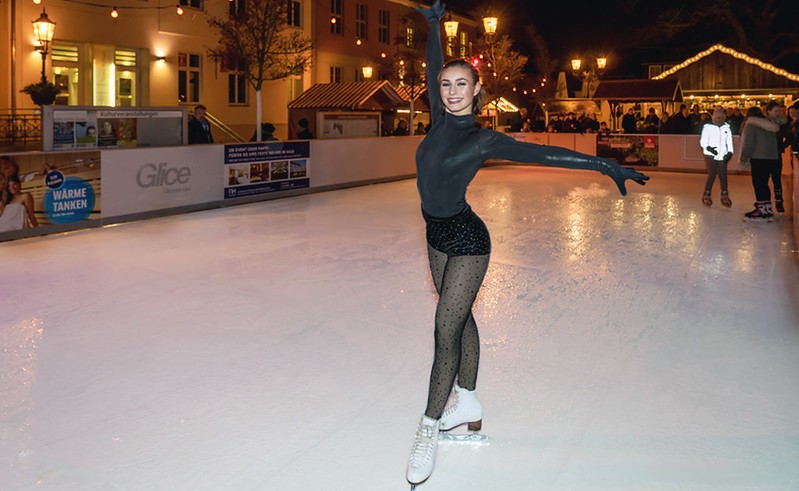Imagine the thrill of having your own ice rink, a place where friends and family can gather for unforgettable skating experiences. Building an ice rink may seem like an ambitious project, but with the proper knowledge and planning, you can create a fantastic space for everyone to enjoy. In this blog post, we’ll unveil the truth about “how much does it cost to build an ice rink”, breaking down the factors that impact construction costs, and exploring the differences between indoor, outdoor, and synthetic rinks, as well as financing options, and more.
Key Takeaways
- The cost of constructing an ice rink is impacted by multiple factors such as location, size, materials used and type.
- Real life examples range from $100k to over $1 million with additional equipment/amenities adding more costs.
- Refrigerated vs synthetic options should be considered for the most cost effective and environmentally friendly choice.
Factors Affecting Ice Rink Construction Costs
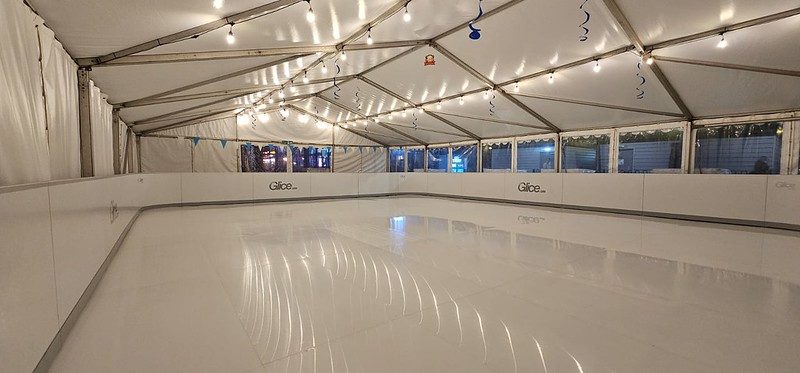
While building an ice rink is an intriguing project, it’s necessary to comprehend how different elements can influence the overall cost. The location, size, and materials used in construction all play significant roles in determining the overall expenses involved in building your dream ice rink.
The type of ice rink you wish to build also impacts the cost. The three levels of play for ice rinks – recreational, student, and professional – have different requirements for materials, amenities, and ice thickness, which will affect the total cost and the type of ice skates used. These factors should be kept in mind while planning your ice rink project as they impact both the initial investment and the recurring maintenance expenses.
Our blog on ice rink business plans gets more into detail about calculating and financing your ice rink project.
Location and Land Acquisition
The cost of land acquisition for your ice rink can vary depending on its location, with both purchasing and leasing options available. Apart from land acquisition, one must also consider the cost of site preparation. These costs will impact the budget available for maintaining ice quality and could influence your decision on whether to purchase or lease the land.
Size of the Rink
The rink size influences the quantity of materials, labor, and time needed for construction, which in turn raises the costs. Standard dimensions for various types of ice rinks are as follows: Hockey rink – 200 feet by 85-100 feet (60 x 26-30); Figure skating rink – 200 feet by 100 feet (60 x 30m); Olympic rink – 200 feet by 98-100 feet (60 x 30 m).
Enlarging an existing ice rink can also impact the construction cost. Depending on the desired size and project requirements, the cost of expansion can range from $100,000 to $1,000,000 or more for a standard-size hockey rink. Additional costs, such as transport, construction, rink accessories, and specialized equipment, may also arise with larger rinks.
Materials and Construction Methods
The selection of construction materials and methods can greatly affect the total cost of constructing an ice rink. Some factors to consider include:
- Higher-quality materials may result in increased expenses but offer benefits such as improved durability, longevity, and ice quality.
- Since 2020, the average increase in the cost of construction materials has been 19%.
- Factors such as inflation, supply chain disruptions, and increased demand have contributed to the rise in construction material costs.
When constructing an ice rink, materials commonly used include:
- Construction lumber
- Plywood or PVC pipe
- Waterproof tarp or plastic sheeting
- Materials designed for high moisture applications
Keeping abreast of current market trends and price fluctuations of materials is important during the planning phase of your ice rink project to achieve the best results.
Types of Ice Rinks: Indoor vs. Outdoor
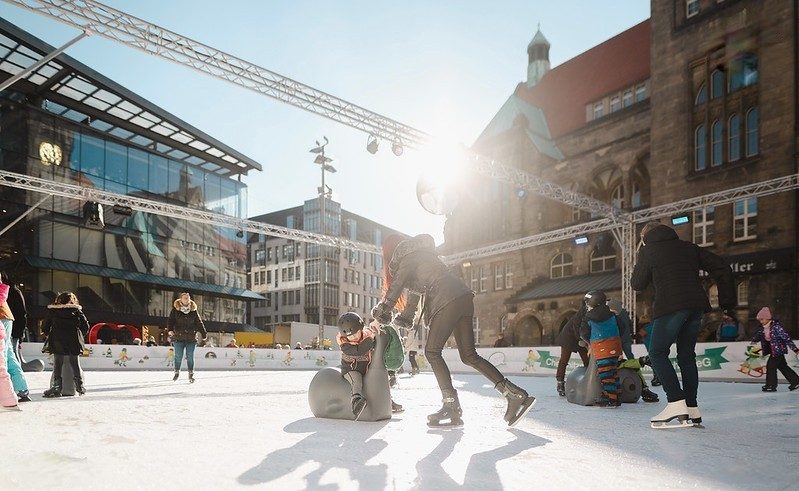
Indoor and outdoor ice rinks provide distinct skating experiences and have unique construction needs and costs. Indoor ice rinks typically have higher construction costs due to the need for a building structure, insulation, and climate control systems.
In contrast, outdoor ice rinks have lower initial costs but may require more maintenance due to weather exposure, especially when it comes to maintaining center ice.
Indoor Rinks
Indoor ice rinks require a building structure, climate control, and insulation to maintain a consistent ice surface. The ice rink cost, estimated for construction, ranges from $100,000 to $950,000 for a rink with real ice and $14,000 to $395,000 for a synthetic ice rink. Size is a major contributor to the overall cost, so if you can get away with a smaller sheet of ice, you can save a tremendous amount of money.
The expense of building an indoor ice rink depends on different aspects like the rink’s size, location, and specific project requirements. Additional costs, such as labor, equipment, and extra amenities or features, must also be taken into consideration. As a general rule of thumb, assuming between $200-250 per sq ft is a good start point for light industrial new building construction.
Outdoor Rinks
Outdoor ice rinks require a simpler construction process, with costs ranging from $25,000 to $150,000. However, outdoor rinks may require more maintenance due to exposure to weather conditions, such as temperature fluctuations and precipitation.
Even though the construction costs are lower, outdoor ice rinks still need to consider recurring expenses like water and electricity for maintaining the ice. The cost of constructing an outdoor hockey rink can vary greatly, with basic community rinks ranging from $50,000 to $500,000.
Refrigeration Systems and Ice Maintenance
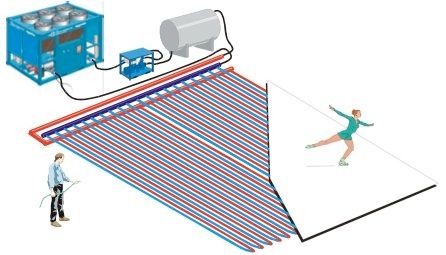
Refrigeration systems and maintenance of ice are significant elements of ice rink construction. Proper installation and maintenance of these systems are essential for maintaining ice quality and ensuring a smooth and safe skating surface.
Refrigeration System Installation
Correct installation of refrigeration systems is required to maintain ice quality and safety. Ice rinks typically use one of four types of refrigeration systems:
- Ammonia/CO2
- Ammonia/glycol
- CO2
- ‘Freon’ systems
These systems can be direct or indirect.
The installation of an ice rink refrigeration system typically takes several days, up to four days in some cases. The cost of such systems can vary significantly based on the size and complexity of the rink, with prices ranging from several hundred thousand to several million dollars.
Ongoing Ice Maintenance
Maintaining the ice regularly is needed to guarantee a smooth and safe skating surface. For refrigerated ice rinks, maintenance tasks include:
- Maintaining the ice layer to a desired thinness
- Performing deep-cleaning of the ice surface
- Adhering to specific conditions for ice-making
- Verifying the ice thickness
- Cleaning the rink surface prior to ice installation
The frequency of ice rink maintenance depends on various factors, such as the size of the rink, the volume of usage, and the type of ice sport being played. It is suggested to schedule regular maintenance every 4-7 days, although larger rinks may require more frequent maintenance.
Synthetic Ice
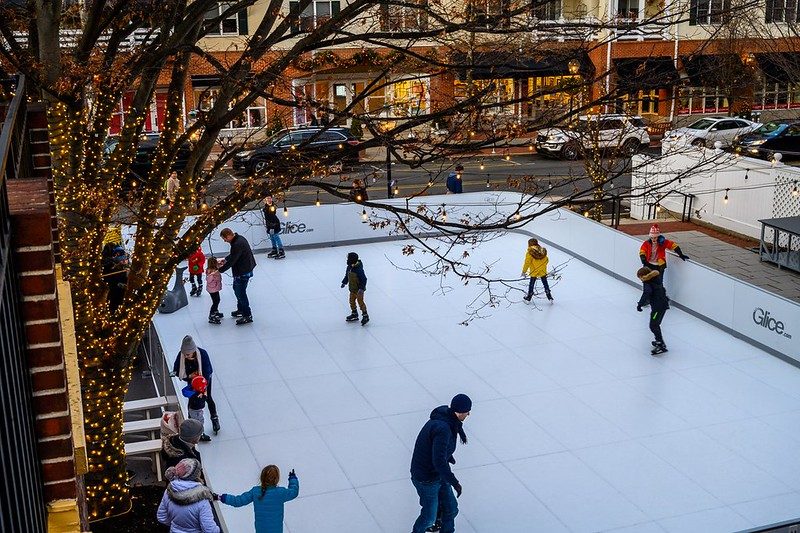
Synthetic ice, a substitute for traditional ice rinks, offers benefits like lower acquisition and maintenance costs and environmental advantages. Composed of a solid polymer material, synthetic ice rinks can be installed using interlocking panels to create a durable and long-lasting surface.
Acquisition Costs
The estimated acquisition costs for synthetic ice can range significantly, beginning at a few hundred dollars and escalating to several thousand dollars for larger rinks. The average cost of synthetic ice depends a lot on the supplier, differentiating in quality.
By offering a more affordable option compared to traditional ice rinks, synthetic ice allows for the creation of ice rinks in locations and climates where maintaining a refrigerated ice rink would be cost-prohibitive or environmentally unsustainable. As a general rule of thumb, synthetic ice rinks cost around $16-28 per sq ft, depending on the quality, connection system, thickness, and supplier.
Maintenance Costs
Maintenance expenses for synthetic ice are considerably less than traditional ice rinks, as there’s no need for refrigeration systems or ice resurfacing gear. The only maintenance needed is regular cleaning and in most cases the application of lubricants or other maintenance liquids.
Here are some tips for the necessary cleaning and maintenance:
- Clean the surface regularly with soap and water or the manufacturer’s maintenance solution.
- Sweep the surface before mopping to remove any loose debris.
- Deep-clean the surface at least once a week to remove any built-up dirt or grime.
- No special chemicals are needed for cleaning.
- With proper care, a synthetic ice rink can last for many years.
More Benefits
Besides lower acquisition and maintenance costs, synthetic ice provides several other advantages. Synthetic ice rinks can be used year-round, providing a consistent skating experience regardless of climate or weather conditions. They also reduce water consumption and energy costs compared to traditional ice rinks, making them a more environmentally friendly option.
Synthetic ice rinks provide a safe and enjoyable experience for skaters of all levels and require minimal maintenance to perform optimally. With their versatility and cost savings, synthetic ice rinks are an attractive choice for many ice skating enthusiasts and facility owners.
Refrigerated vs. Synthetic Ice
During the planning phase of your ice rink project, comparing refrigerated and synthetic ice rinks is important to decide the most suitable option for your specific needs. Refrigerated ice rinks utilize real ice created by freezing water and require constant maintenance and resurfacing. On the other hand, synthetic ice rinks implement a form of plastic ice and require less maintenance.
The cost of constructing a synthetic ice rink is typically lower than that of a refrigerated ice rink, making it a more cost-effective alternative. Synthetic ice rinks also offer environmental benefits, as they do not require electricity or water for maintenance and are composed of sustainable materials. By comparing the costs, maintenance requirements, and environmental impacts of refrigerated and synthetic ice rinks, you can make an informed decision about the best option for your project.
Additional Equipment and Amenities
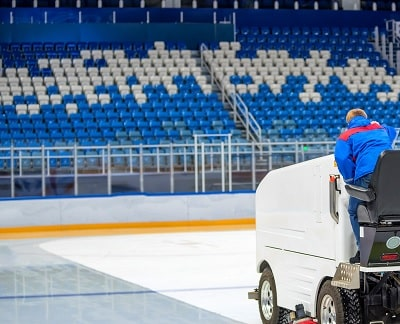
Offering rental skates, equipment, and other amenities can increase the total cost of constructing an ice rink. However, these additional features can enhance the customer experience and generate revenue, making them a worthwhile investment.
Rental Skates and Equipment
Offering rental skates and equipment is essential for attracting customers and generating revenue. The rink cost, including the cost of rental skates at an ice rink, can vary depending on the location and type of skates. To reduce the cost of procuring rental skates and equipment, consider acquiring used items, collaborating with local skating clubs or suppliers for cost-effective pricing options, or outsourcing to an external vendor. Expect to pay around $60-100 for a bulk order of user friendly buckle up skates, where as high end hockey and figure skates can cost between $400-800 per pair.
To keep a well maintained and smooth surface on refrigerated ice, make sure to look into Zambonis as well. This blog will help you with the decision making process.
Providing well-maintained rental skates and equipment ensures a positive experience for your customers and helps to maintain a reputable image for your ice rink. So include the annual expendure for routine maintenance and repair of rental skates and equipment.
Amenities and Facilities
Amenities and facilities, such as locker rooms, seating areas, and concession stands, can enhance the customer experience and increase profitability. Installing seating areas in an ice rink can also vary in cost.
Setting up a concession stand at an ice rink may also contribute to the overall cost. You can opt for a pre-made booth or contruct a new medium-sized concession stand. Constructing your booth rink will be more expensive than getting an already constructed one. Providing a variety of amenities and facilities can help to attract more customers and improve their overall satisfaction with your ice rink.
Financing Options for Ice Rink Construction

Financing the construction of an ice rink can be a substantial challenge, but there are several alternatives that can help fund your project. Some viable financing options for ice rink construction include:
- Government grants
- Private investors
- Bank loans
- Crowdfunding
These options provide flexibility for funding the project.
Government grants can help cover costs associated with constructing or rehabilitating public and recreational facilities, as well as grants for female hockey programs and community-based ice rinks. Private investors can offer equity financing or loans, while bank loans can provide traditional financing options, such as Small Business Administration (SBA) loans and commercial construction loans. Crowdfunding can also help collect small amounts of money from a large number of people, allowing individuals or organizations to contribute to the project and receive rewards or incentives in return.
Summary
In conclusion, building an ice rink is a rewarding endeavor that requires careful planning and consideration of various factors, such as location, size, materials, and financing options. Whether you choose to construct a refrigerated or synthetic ice rink, understanding the costs and maintenance requirements involved will help ensure your rink is a success. With the right knowledge and planning, you can create a fantastic ice rink that provides endless enjoyment for friends, family, and the community.
Frequently Asked Questions
Do ice rinks make a profit?
Many ice rinks struggle to balance their income throughout the year, making profitability a difficult task. However, there are some profitable rinks, typically those with low or no debt service, that show success is achievable.
Can you make your own ice rink?
You can easily make your own ice rink using plywood walls, or bales of hay. The boarder needs to be built up more in order to help hold the water and create a level surface.
How to build a hockey rink?
Stake out your rink, build a box frame and create a second layer if needed. Install the liner and fill it with water to create a backyard ice rink. Read more about it here.
How thick should a home ice rink be?
For a home ice rink to stay solid and hold the weight of a person, it should be at least 5cm (2”) thick.
When should I build an ice rink?
For the best results, consider installing your ice rink frame in November or December and the liner in December or January. Of course, this depends on your location so don’t worry if you miss these time periods; just ensure to install your rink during the cold winter months!

